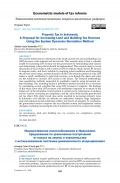The current hottest issue in Indonesia is the small amount of Land and Building Tax (LBT) revenue at the national and local levels. This research aims to find a valuable model for increasing LBT revenue for the government by formulating ideal clauses and determining what policies should be implemented. This research aims to reveal the practice of tax avoidance and evasion on LBT tax objects, which causes LBT income to stagnate yearly, and find a solution by mapping actual conditions and forecasting the next ten years using a system dynamics model. The research question is why LBT makes a small contribution to total state revenue, even though the object and what are the solutions to increase LBT income in the future. The research methodology uses quantitative methods supported by qualitative analysis using dynamical system modeling. This modeling makes it possible to predict increases in tax revenues by considering several variables that cause LBT revenues to stagnate. The findings of this study show that LBT revenues will proliferate compared to revenues in the initial year of the simulation if intervention is carried out by reducing tax avoidance and tax evasion, increasing tax compliance, and the value of the income growth ratio per tax object. This study found nine actors essential in increasing property taxes in Indonesia: civil officials, tax officials, tax authorities, notaries, large companies, state and regional-owned enterprises, sellers, and buyers of property. In conclusion, the government needs to improve the tax collection system and implement various strategies, including increasing the role of notaries to prevent tax evasion in housing.
